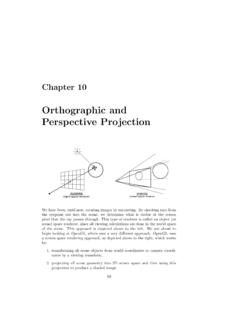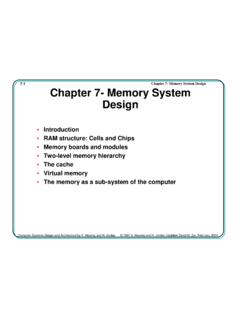Transcription of Tips for Optimizing C/C++ Code - Clemson University
1 Tips for Optimizing C/C++ Ahmdal s Law:Speedup=timeoldtimenew=1(1 funccost)+funccost/funcspeedup Wheref unccostis the percentage of the program runtime used by the functionf unc, andf uncspeedupisthe factor by which you speedup the function. Thus, if you optimize the functionT riangleIntersect(), which is 40% of the runtime, so that it runstwice as fast, your program will run 25% faster (1(1 )+ ). This means infrequently used code ( , the scene loader) probably should be optimized little (if at all). This is often phrased as: make the common case fast and the rare case correct. for correctness first, then optimize! This does not mean write a fully functional ray tracer for 8 weeks, then optimize for 8 weeks!
2 Perform optimizations on your ray tracer in multiple steps. Write for correctness, then if you know the function will be called frequently, perform obvious optimiza-tions. Then profile to find bottlenecks, and remove the bottlenecks (by optimization or by improving the al-gorithm). Often improving the algorithm drastically changes the bottleneck perhaps to a function youmight not expect. This is a good reason to perform obvious optimizations on all functions you know willbe frequently I know who write very efficient code say they spend at least twice as long Optimizing code as they spendwriting are expensive. Minimize their use wheneverpossible. Function calls requiretwojumps, in addition to stack memory manipulation.
3 Prefer iteration over recursion. Use inline functions for short functions to eliminate function overhead. Move loops inside function calls ( , changefor(i=0;i<100;i++) DoSomething();intoDoSomething(){for(i=0; i<100;i++){..} }). Long chains requirelotsof jumps for cases near the end of the chain (inaddition to testing each condition). If possible, convert to aswitchstatement, which the compiler some-times optimizes into a table lookup with a single jump. If aswitchstatement is not possible, put the mostcommon clauses at the beginning of the if about the order of array indices. Two and higher dimensional arrays are still stored in one dimensional memory. This means (for C/C++ arrays)array[i][j]andarray[i][j+1]a re adjacent to each other, whereasarray[i][j]andarray[i+1][j]may be arbitrarily far apart.
4 Accessing data in a more-or-less sequential fashion, as stored in physical memory, candramaticallyspeedup your code (sometimes by an order of magnitude, or more)! When modern CPUs load data from main memory into processor cache, they fetch more than a singlevalue. Instead they fetch a block of memory containing the requested data and adjacent data (acacheline). This means afterarray[i][j]is in the CPU cache,array[i][j+1]has a good chance of already beingin cache, whereasarray[i+1][j]is likely to still be in main about instruction-level-parallelism. Even though many applications still rely on single threadedexecution, modern CPUs already have asignificant amount of parallelism inside a single core.
5 Thismeans a single CPU might be simultaneouslyexecuting 4 floating point multiplies, waiting for 4 memory requests, and performing a comparison for anupcoming branch. To make the most of this parallelism, blocks of code ( , between jumps) need to have enough indepen-dent instructions to allow the CPU to be fully utilized. Think about unrolling loops to improve this. This is also a good reason to use inline the number of local variables. Local variables are normally stored on the stack. However ifthere are few enough, they can instead bestored in registers. In this case, the function not only getsthe benefit of the faster memory access of datastored in registers, but the function avoids the overhead ofsetting up a stack frame.
6 (Do not, however, switch wholesale to global variables!) the number of function parameters. For the same reason as reducing local variables they are also stored on the structures by reference, not by value. I know of no case in a ray tracer where structures should be passed by value (even simple ones like Vectors,Points, and Colors). you do not need a return value from a function, do not define to avoid casting where possible. Integer and floating point instructions often operate on different registers, so a cast requires a copy. Shorter integer types (char and short) still require the useof a full-sized register, and they need to be paddedto 32/64-bits and then converted back to the smaller size before storing back in memory.
7 (However, thiscost must be weighed against the additional memory cost of a larger data type.) very careful when declaring C++ object variables. Use initialization instead of assignment (Color c(black);is faster thanColor c; c = black;). default class constructors as lightweight as possible. Particularly for simple, frequently used classes ( , color, vector, point, etc.) that are manipulated fre-quently. These default constructors are often called behind your back, where you are not expecting it. Use constructor initializer lists. (UseColor::Color() : r(0), g(0), b(0){}rather thanColor::Color(){r= g = b = 0;}.) shift operations>>and<<instead of integer multiplication and division, where careful using table-lookup functions.
8 Many people encourage using tables of precomputed values for complex functions ( , trigonometricfunctions). For ray tracing, this is often unnecessary. Memory lookups are exceedingly (and increasingly)expensive, and it is often as fast to recompute a trigonometric function as it is to retrieve the value frommemory (especially when you consider the trig lookup pollutes the CPU cache). In other instances, lookup tables may be quite useful. For GPU programming, table lookups are oftenpreferred for complex most classes, use the operators+=,-=,*=, and/=, instead of the operators+,-,*, and/. The simple operations need to create an unnamed, temporary intermediate object. For instance:Vector v = Vector(1,0,0) + Vector(0,1,0) + Vector(0,0,1);creates five unnamed, temporaryVectors:Vector(1,0,0),Vector(0, 1,0),Vector(0,0,1),Vector(1,0,0) + Vector(0,1,0), andVector(1,0,0) +Vector(0,1,0) + Vector(0,0,1).
9 The slightly more verbose code:Vector v(1,0,0); v+= Vector(0,1,0); v+= Vector(0,0,1);only creates twotemporary Vectors:Vector(0,1,0)andVector(0,0,1). This saves 6 functions calls (3 constructors and 3destructors). basic data types, use the operators+,-,*, and/instead of the operators+=,-=,*=, and/=. declaring local variables. Declaring object variable always involves a function call (to the constructor). If a variable is only needed sometimes ( , inside an if statement) only declare when necessary, so theconstructor is only called if the variable will be objects, use the prefix operator(++obj)instead of the postfix operator(obj++). This probably will not be an issue in your ray tracer.
10 A copy of the object must be made with the postfix operator (which thus involves an extra call the theconstructor and destructor), whereas the prefix operator does not need a temporary careful using templates. Optimizations for various instantiations may need to be different! The standard template library is reasonably well optimized, but I would avoid using it if you plan toimplement an interactive ray tracer. Why? By implementing it yourself, you ll know the algorithmsit uses, so you will know the most efficientway to use the code. More importantly, my experience is that debug compiles of STL libraries are slow. Normally this isn t aproblem, except you will be using debug versions for profiling.














